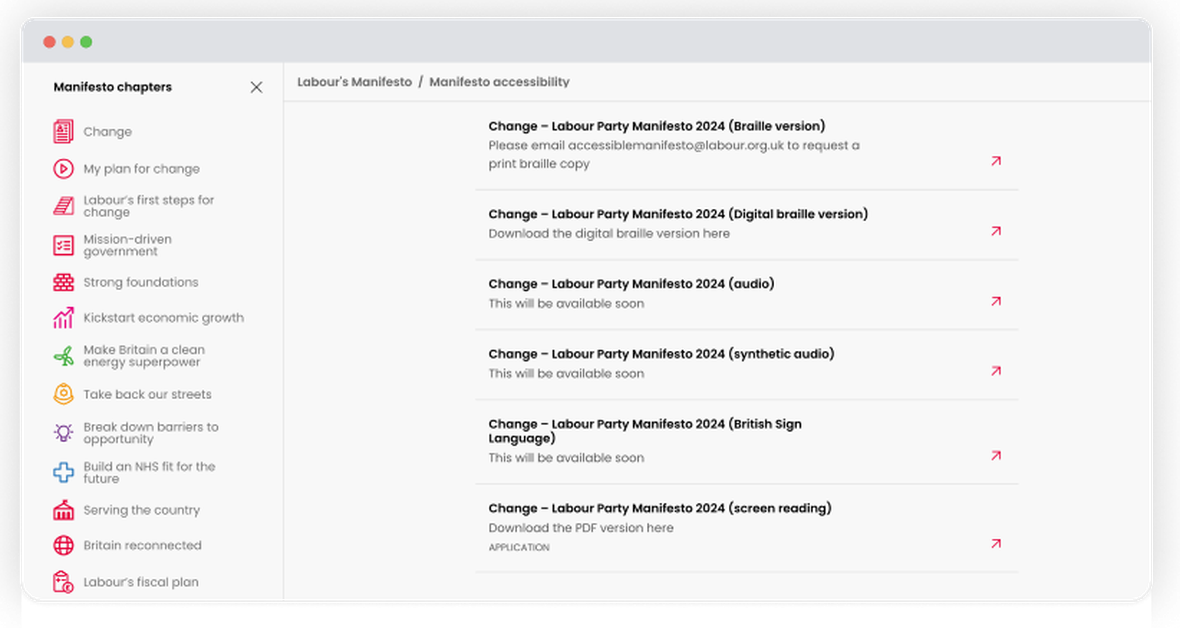
Web Accessibility in Politics: An Audit of Major Party Websites
As the UK faces a general election, the accessibility of our political parties' websites should face scrutiny.
At Giant Digital, we are dedicated to supporting charities; after all, our previous research shows that poor digital accessibility could be costing millions in online donations. This election season provides a crucial opportunity to reflect on how accessible digital platforms can bolster all individuals’ user experience, especially those who rely on assistive technologies.
The state of political websites
Under the Disability Discrimination Act 1995 (DDA), all people were given the legal a right of access to goods, facilities, services and premises. But how has that been applied to websites? From the introduction of this legislation to the present day, we argue that websites in all sectors have been overlooked in terms of accessibility.
Political parties’ websites serve as important tools for communicating policies, values, and updates. However, not all voters have equal access to this information. Websites that fail to meet accessibility standards can inadvertently disenfranchise individuals with disabilities, including those with visual, auditory, cognitive, and motor impairments. There is a clear parallel with the state of brick-and-motor businesses pre-1995 when there was no official legal precedent to assist those that wished to access them.
Giant audited the websites of the major political parties:
- The Conservative Party, https://www.conservatives.com/
- The Labour Party, https://labour.org.uk/
- The Scottish National Party, https://www.snp.org/
- The Green Party of England and Wales, https://greenparty.org.uk/
- The Liberal Democrat Party, https://www.libdems.org.uk/
- The Democratic Unionist Party, https://mydup.com/
- Sinn Fein, https://vote.sinnfein.ie/
- Plaid Cymru, https://www.plaid.cymru/
- The Social Democratic and Labour Party, https://www.sdlp.ie/
- Alba Party, https://www.albaparty.org/
- The Alliance Party of Northern Ireland, https://www.allianceparty.org/
- Reform UK, https://www.reformparty.uk/
- The Workers Party of Britain, https://workerspartybritain.org/
Most common accessibility issues
1. Lack of keyboard navigation: Websites that do not support keyboard-only navigation can be inaccessible to users with motor impairments.
Party | Rating | Key Findings |
Conservatives | Acceptable | No clear focus around some links and buttons |
Labour | Acceptable | No clear focus around some links and buttons |
Scottish National Party | Poor | Search filters impossible to navigate |
Liberal Democrat | Poor | Menu dropdowns impossible to navigate |
Green | Acceptable | No clear focus around CTAs |
Democratic Unionist Party | Good | Occasional lack of focus on links and buttons |
Sinn Féin | Poor | No focus around links and buttons |
Plaid Cymru | Excellent | Fully navigable |
Social Democratic and Labour Party | Poor | Very few elements are tabbable. |
Alba Party | Good | Occasional lack of focus on links and buttons |
Alliance Party of Northern Ireland | Poor | No focus around links and buttons and navigation is inaccessible. |
Reform UK | Good | Occasional lack of focus on links and buttons |
Workers Party of Britain | Good | Clear focus but difficult to navigate carousel components |
2. Non-descriptive links and buttons: Links and buttons without descriptive text can be confusing for screen reader users.
Party | Rating | Key Findings |
Conservatives | Poor | Very few descriptive links |
Labour | Acceptable | Descriptive links could be more specific |
Scottish National Party | Acceptable | Descriptive links could be more specific |
Liberal Democrat | Acceptable | Descriptive links could be more specific |
Green | Poor | Very few descriptive links and clickable imagery is without alt tags. |
Democratic Unionist Party | Poor | Clickable imagery are without alt tags. |
Sinn Féin | Poor | Clickable images are without alt tags and not obvious links |
Plaid Cymru | Poor | Clickable images are without alt tags. |
Social Democratic and Labour Party | Good | Majority of links are clear and descriptive with occasional non-specific ones |
Alba Party | Good | Majority of links are clear and descriptive with occasional non-specific ones |
Alliance Party of Northern Ireland | Poor | Very few descriptive links |
Reform UK | Excellent | CTAs are clear in what they ask of a user. |
Workers Party of Britain | Good | Most clear but a few descriptive links could be more specific |
3. Poor contrast and readability: Many political websites suffer from poor colour contrast and small font sizes, making it difficult for people with visual impairments to read content.
Party | Rating | Key Findings |
Conservatives | Good | Overall contrast is clear but readability challenging for footer links |
Labour | Poor | Grey text on white background has a poor contrast and lacks readability. |
Scottish National Party | Excellent | Clear contrast and readability. |
Liberal Democrat | Excellent | Clear contrast and readability. |
Green | Acceptable | Occasional use of a light green on white background which could be improved slightly. |
Democratic Unionist Party | Good | Overall contrast is clear but readability challenging for footer links |
Sinn Féin | Acceptable | Hover effects make text unclear. |
Plaid Cymru | Good | Overall contrast is clear but readability challenging for footer links |
Social Democratic and Labour Party | Acceptable | Overall strong but video content containing text overlay is somewhat unclear at times. |
Alba Party | Excellent | Clear contrast and readability. |
Alliance Party of Northern Ireland | Excellent | Clear contrast and readability. |
Reform UK | Acceptable | Main text is clear but poor visibility on certain imagery with text overlay. |
Workers Party of Britain | Good | Generally clear but poor visibility on certain imagery with text overlay. |
4. Inaccessible downloadable documents: Political manifestos often come in PDF formats that are not tagged properly for screen readers.
Party | Rating | |
Conservatives | Poor | No tags to define content. |
Labour | Poor | No tags to define content. |
Scottish National Party | Poor | No tags to define content. |
Liberal Democrat | Poor | No tags to define content. |
Green | Poor | No tags to define content. |
Democratic Unionist Party | Poor | No tags to define content. |
Sinn Féin | Poor | No tags to define content. |
Plaid Cymru | Poor | No tags to define content. |
Social Democratic and Labour Party | Acceptable | Most content presented as HTML documents with average accessibility features. No alternative formats to review. |
Alba Party | Accetable | Most content presented as HTML documents with average accessibility features. No alternative formats to review. |
Alliance Party of Northern Ireland | Poor | Incorrect metadata and inconsistent hierarchy of content. |
Reform UK | Poor | Incorrect metadata and inconsistent hierarchy of content. |
Workers Party of Britain | Acceptable | Most content presented as HTML documents with average accessibility features. No alternative formats to review. |
The role of charities
Charities play a vital role in advocating for the rights of all individuals, including those with accessibility needs. By ensuring their websites are fully accessible, charities can set an example and allow for a more inclusive digital environment. This not only enhances user experience but also aligns with legal obligations under the Equality Act 2010.
During an election period, this key sector can mobilise to steer towards inclusivity both in the digital and physical world.
A glimmer of hope?
The question arises; how much is accessibility at the forefront website delivery? Furthermore, how much is accessibility considered when publishing a valuable message - say a political manifesto?
We placed considerable focus on the most common accessibility issues we mentioned - inaccessible downloadable documents - It is important to highlight this, not just through the meeting conformance with regards to WCAG guidelines, but how manifesto documentation is put on offer to those that may not have the capability to sift through information via a downloadable document that is made up of text and nothing else?
There was an example of good intention in our research; the Labour Manifesto aims to offer users a wide variety of accessible options.

Found within are many manifesto formats spanning Braille, easy-read, audio and BSL (British Sign Language). Worryingly, many of these alternative formats are accompanied with the comment: ‘This will be available soon’. With time running out before the General Election on July 4th, it is hard to see how useful these implied options will be for a user who needs this information today. Perhaps this is an insight into the inner workings of the political world - an intent to do good but lacking the technical know-how to enact real change?
Despite empty promises of accessibility, we should take an optimistic view of what is possible. This can be a call to action and an opportunity to deliver this good intent, offering access to all who need it.
Making accessibility a priority - a call to action
As we see from the Labour Manifesto, we have seen positive action combined with shortcomings that must be addressed, and that must come in the form of focusing more attention on accessibility. We can draw lessons to improve our own digital platforms:
Conduct an accessibility audit: With a thorough review of your website for accessibility issues using tools like WAVE, Axe, or Lighthouse you can feel empowered to identify and prioritise areas for development.
- Implement WCAG: Adhering to the Web Content Accessibility Guidelines (WCAG) 2.1 will ensure that your website meets international standards. By focusing on principles like perceivability, operability, understandability, and robustness, your website can welcome a larger audience of users.
- Provide accessible documents: Ensuring that all downloadable content, such as PDFs and Word documents, are accessible whilst using proper tagging, providing alt text for images, and offering content in multiple formats reinforces your brand identity as a leader in accessibility.
- Design for keyboard navigation: Often missed in web design, it is integral to make sure that all interactive elements can be accessed via keyboard alone. This includes forms, menus, and multimedia controls.
- Engage users with accessibility needs: Involving individuals with disabilities in the testing phase of your website development may seem like a no brainer but, like so many elements we have mentioned, can so easily be overlooked. Their feedback is invaluable for identifying and addressing real-world accessibility issues.
Accessibility - leading by example
By prioritising accessibility, the UK charity sector can lead by example and influence other sectors, including our political organisations, to follow in kind. An accessible website not only broadens your reach but also reinforces your commitment to inclusivity and equality.
The lead-up to the UK general election highlights the critical need for accessible digital content. By making our content more accessible, we can empower all to participate in our democratic process.
If your charity needs web design and development services with a focus on accessibility, call Giant Digital on 0208 152 4572 or send us your details today. Our expert team is dedicated to creating accessible digital user experiences for all.










